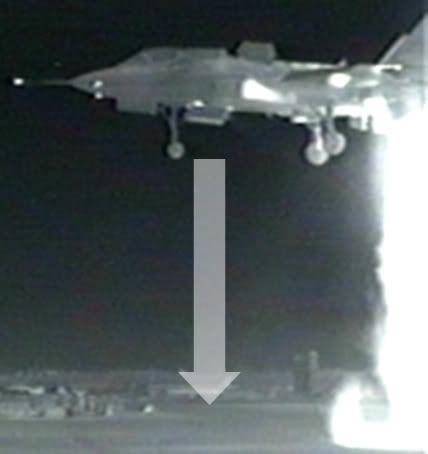Many people have asked me why we never did a supersonic Harrier. My answer to them all was that the Harrier layout did not allow it. To fly supersonically requires an engine specifically designed to produce a very high speed exhaust. In other words the nature of the thrust is important, not just the amount of it.
The physics behind this are remarkably simple. The thrust of a jet engine is calculated by multiplying together just two numbers M and V. M is the mass or amount of air passing through the engine in a given time (pounds per second using the units I was taught at school) while V is the speed increase that the engine imparts to the air as it passes through the engine (feet per second in my day).
With both the Harrier (a typical subsonic fighter) and the F-16 (a typical supersonic fighter) the product of M x V is about 20,000. However the difference between the two aircraft is that the Harrier engine gets its 20,000 by using a big value of M and a modest value of V while the F-16 engine uses a modest value of M but gives it a bigger V.
While 20,000 lb of thrust is plenty to get a small fighter supersonic, it will only do so if the V component of that 20,000 is big enough.
The Harrier engine deliberately uses a small V because a big V would have the ability to damage the surface below it during a VTO and, if not the surface then the under-surfaces of the aircraft itself. Additionally and very importantly, an engine that produces a big V can only do this by making the exhaust very hot. Immersing the bottom of a Harrier and its rubber tyres in such a hot environment would clearly not work.
Helicopters are subject to the same physics regarding thrust so, in the case of a large 20,000 lb helicopter, it uses a huge M (captured by the rotor) and gives it a very small V (the downwash we can feel or see blowing stuff about under a helicopter) but the product is still 20,000.
All this means that you need a different configuration of aircraft from that of the Harrier if you want to produce a practical supersonic vertical landing aircraft.
Finally, any succesful jet lift vertical landing design MUST as in ABSOLUTELY MUST keep efflux that has had fuel burned in it out of the intake during VTO or VL. The Harrier does this by having a front nozzle efflux that splashes reawards and stops the hot air coming forwards. The B does the same thing using the fan efflux.
